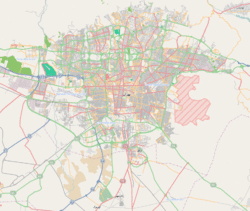Haim Synagogue
| Haim Synagogue | |
|---|---|
 The synagogue entrance in 2017 | |
| Religion | |
| Affiliation | Orthodox Judaism |
| Ecclesiastical or organisational status | Synagogue |
| Status | Limited activity |
| Location | |
| Location | 30 Tir Street, Old Jewish Quarter, Tehran, 12 (Park-e Shahr) |
| Country | Iran |
Location of the synagogue in Tehran | |
| Geographic coordinates | 35°41′34.0″N 51°24′47.6″E / 35.692778°N 51.413222°E |
| Architecture | |
| Architect(s) | Azizollah Banayan |
| Type | Synagogue architecture |
| Style | Qajar period |
| Funded by |
|
| Completed | 1913 |
| [1] | |
The Haim Synagogue (Persian: کنیسه حییم, romanized: Kenisā-ye Hayim; Hebrew: בית הכנסת חַיִּים) is an Orthodox Jewish congregation and synagogue, located in 30 Tir Street, formerly known as Qavam-os-Saltane, in central Tehran, Iran.[2][3][4][5]
As of February 2016[update], the synagogue was opened only on the occasions of Shabbat and the High Holy Days, due mainly to emigration and decline in membership.[5]
History
[edit]The Haim Synagogue was built following the Iranian Constitutional Revolution in 1913, under the reign of Ahmad Shah Qajar, by two Iranian Jewish residents Eshagh Sedgh and Eshagh Moradoff.[6] It has often been considered the first urban synagogue in Iran. Prior to its construction, most synagogues in Iran were built in ghettos.[6]
The building was designed by Azizollah Banayan, the only Jewish architect at the time.[1]
World War II
[edit]By the time of World War II, the Haim Synagogue hosted a number of Polish Jewish refugees.[7] After an increase in the number of Polish Jewish refugees, the Ashkenazi Danial Synagogue was built near the Haim Synagogue in 1940.[6]
Operation Ezra and Nehemiah
[edit]In the 1950s, the Haim Synagogue was used as a refugee camp to host a number of Iraqi Jewish refugees, who immigrated to Israel via Iran as part of Operation Ezra and Nehemiah.[7][5]
Gallery
[edit]-
A panel in the synagogue, reading "this is the God's gate; the righteous will enter it" (Psalm 118:20).
-
Entrance of the yard.
-
Haim Synagogue from the outside.
-
Detail of the synagogue's bema.
-
Synagogue detail
See also
[edit]References
[edit]- ^ a b Sohrabi, Narciss M. (2021). "Tehran synagogues: the socio-cultural topographies and architectural typologies". Journal of Modern Jewish Studies: 9. doi:10.1080/14725886.2021.1971934.
- ^ Massil, Stephen W. (2002). The Jewish Year Book. Vallentine Mitchell. p. 158.
- ^ "Different Dining Experience in Downtown Tehran". Financial Tribune. August 21, 2017.
- ^ "قدم زدن در خيابان اديان". Hamshahri (in Persian). Archived from the original on December 29, 2016. Retrieved December 28, 2016.
- ^ a b c "Take a virtual tour of Haim synagogue in Tehran, Iran". The Iran-Israel Observer. February 6, 2016. Retrieved December 28, 2016.
- ^ a b c "خیابانی برای گفتگوی ادیان در تهران". Farda News (in Persian). Retrieved December 28, 2016.
- ^ a b "Iran". Momentum Tours & Travel. Florida. Retrieved July 23, 2017.
Further reading
[edit]- Sohrabi, Narciss M. (2021). "Tehran synagogues: the socio-cultural topographies and architectural typologies". Journal of Modern Jewish Studies. doi:10.1080/14725886.2021.1971934.







